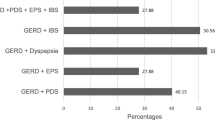Abstract
Various reports on the prevalence of gastroesophageal reflux disease (GERD) and uninvestigated dyspepsia have been conducted in Western countries. We sought to determine the frequency of GERD symptoms and uninvestigated dyspepsia in Korea. Telephone interviews were conducted with 1,044 individuals. Of all subjects, 7.1% reported that GERD symptoms were present at least once a week, and 3.8% at least twice a week. The prevalence of heartburn according to educational level and acid regurgitation according to age was significantly different (P < 0.05). The prevalence of uninvestigated dyspepsia was reported as 12.2%. Dyspepsia was divided into subgroups of 34% ulcer-like, 56% dysmotility-like, and 10% nonspecific. The occurrence of dyspepsia did not vary according to age, gender, educational level and household income. As frequency of GERD symptoms increased, quality of life significantly decreased. We concluded that GERD symptoms and uninvestigated dyspepsia were prevalent in Korea. The prevalence was similar to that of other Asian countries.





Similar content being viewed by others
References
Talley NJ, Zinsmeister AR, Schleck CD, Melton LJ 3rd (1992) Dyspepsia and dyspepsia subgroups: a population-based study. Gastroenterology 102:1259–1268
Drossman DA, Li Z, Andruzzi E, Temple RD, Talley NJ, Thompson WG, Whitehead WE, Janssens J, Funch-Jensen P, Corazziari E et al. (1993) U.S. householder survey of functional gastrointestinal disorders. Prevalence, sociodemography, and health impact. Dig Dis Sci 38:1569–1580
Talley NJ, Colin-Jones D, Koch KL et al (1991) Functional dyspepsia: a classification with guidelines for diagnosis and management. Gastroenterol Int 4:145–160
Klauser AG, Schindlbeck NE, Muller-Lissner SA (1990) Symptoms in gastro-oesophageal reflux disease. Lancet 335:205–208
Silverstein BD, Pope CE 2nd (1980) Role of diagnostic tests in esophageal evaluation. Am J Surg 139:744–748
Jones RH (2002) Approaches to uninvestigated dyspepsia. Gut 50(suppl 4):iv42–iv46
Wong BC, Kinoshito Y (2006) Systematic review on epidemiology of gastroesophageal reflux disease in Asia. Clin Gastroenterol and hepatol 4:398–407
Locke GR, Talley NJ, Weaver AL, Zinmeister AR (1994) A new questionnaire for gastroesphageal reflux disease. Mayo Clin Proc 69:539–547
Wong WM, Lai KC, Lam KF et al (2003) Prevalence, clinical spectrum and health care utilization of gastro-oesophageal reflux disease in Chinese population: a population-based study. Aliment Pharmacol Ther 18:595–604
Mahadeva S, Goh KL (2006) Epidemiology of functional dyspepsia: a global perspective. World J Gastroenterol 7;12:2661–2666
Kish L (1965) Sampling organizations and groups of unequal sizes. Am Sociol Rev 30:564–572
Guillemin F, Saraux A, Fardellone P, Guggenbuhl P, Behier JM, Coste J (2003) Epidemiology Committee of the French Society of Reumatology: Detection of cases of inflammatory rheumatic disorders: performance of a telephone questionnaire designed for use by patient interviewers. Ann Rheum Dis 62:957–963
Dent J, Brun J, Fendrick AM et al (1999) On behalf of the Genval workshop Group. An evidence-based appraisal of reflux disease management—the Genval Workshop Report. Gut 44(suppl 2):S1–S16
Cho YS, Choi MG, Jeong JJ et al (2005) Prevalence and clinical spectrum of gastroesophageal reflux: a population-based study in Asan-si, Korea. Am J Gastroenterol 100:747–753
Goh KL, Chang CS, Fock KM, Ke M, Park HJ, Lam SK (2000) Gastroesophageal reflux disease in Asia. J Gastroenterol Heptol 15:230–238
Dent J, El-Serag HB, Wallander MA, Johansson S (2005) Epidemiology of gastro-oesophageal reflux disease: a systematic review. Gut 54:710–717
Mohammed I, Cherkas LF, Riley SA, Spector TD, Trudgill NJ (2003) Genetic influences in gastro-oesophageal reflux disease: a twin study. Gut 52:1085–1089
Isolauri J, Laippala P (1995) Prevalence of symptoms suggestive of gastro-oesophageal reflux disease in an adult population. Ann Med 27:67–70
Locke GR 3rd, Talley NJ, Fett S, Zinsmeister AR, Melton LJ 3rd (1997) Prevalence and clinical spectrum of gastroesophageal reflux: a population-based study in Olmsted country, Minnesota. Gastroenterology 112:1448–1456
Locke GR 3rd, Talley NJ, Fett SL, Zinsmeister AR, Melton LJ 3rd (1999) Risk factors associated with symptoms of gastroesophageal reflux. Am J Med 106:642–649
El-Serag HB, Petersen NJ, Carter J, Graham DY, Richardson P, Genta RM, Rabeneck L (2004) Gastroesophageal reflux among different racial groups in the United States. Gastroenterology 126:1692–1699
Diaz-Rubio M, Moreno-Elola-Olaso C, Rey E, Locke GR 3rd, Rodriguez-Artalejo F (2004) Symptoms of gastro-oesophageal reflux: prevalence, severity, duration and associated factors in a Spanish population. Aliment Pharmacol Ther 19:95–105
Gschossmann JM, Haag S, Holtmann G (2001) Epidemiological trends of functional gastrointestinal disorders. Dig Dis 19:189–194
Jones R, Lydeard S (1989) Prevalence of symptoms of dyspepsia in the community. BMJ 298:30–32
Talley NJ, Silverstein MD, Agreus L, Nyren O, Somenberg A, Holtmann G (1998) AGA technical review: evaluation of dyspepsia. American Gastroenterological Association. Gastroenterology 114:582–595
Olmos JA, Pogorelsky V, Tobal F et al (2006) Uninvestigated dyspepsia in Latin America: A population-based study. Dig Dis Sci 51:1922–1929
Shaib Y, El-Serag HB (2004) The prevalence and risk factors of functional dyspepsia in a multiethnic population in the United States. Am J Gastroenterol 99:2210–2216
Chang L (2004) Review article: epidemiology and quality of life in functional gastrointestinal disorders. Aliment Pharmacol Ther 20 Suppl 7:31–39
Halder SL, Locke GR 3rd, Talley NJ, Fett SL, Zinsmeister AR, Melton LJ 3rd (2004) Impact of functional gastrointestinal disorders on health-related quality of life: a population-based case-control study. Aliment Pharmacol Ther 19:233–242
Talley NJ, Weaver AL, Zinsmeister AR (1995) Impact of functional dyspepsia on quality of life. Dig Dis Sci 40:584–589
Wiklund I, Carlsson J, Vakil N (2006) Gastroesophageal reflux symptoms and well-being in a random sample of the general population of a Swedish community. Am J Gastroenterol 101:18–28
Acknowledgement
This work was supported by the research fund of Hanyang University (HY-2005-1).
Author information
Authors and Affiliations
Corresponding author
Rights and permissions
About this article
Cite this article
Yang, S.Y., Lee, O.Y., Bak, Y.T. et al. Prevalence of Gastroesophageal Reflux Disease Symptoms and Uninvestigated Dyspepsia in Korea: A Population-Based Study. Dig Dis Sci 53, 188–193 (2008). https://doi.org/10.1007/s10620-007-9842-0
Received:
Accepted:
Published:
Issue Date:
DOI: https://doi.org/10.1007/s10620-007-9842-0




